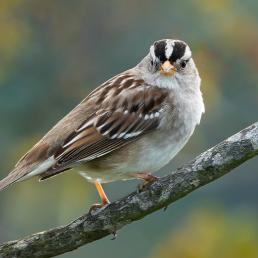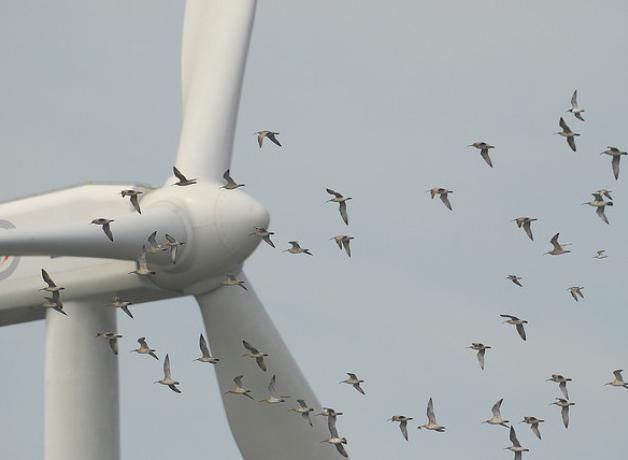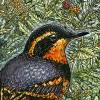

Join BirdNote tomorrow, November 30th!
Illustrator David Sibley and actor H. Jon Benjamin will face off in the bird illustration battle of the century during BirdNote's Year-end Celebration and Auction!
January 2013: Birds take advantage of windy ridges and other land-forms that create thermals and updrafts to carry them on their migrations. These same windy locations recommend themselves for wind-power turbines. It’s a tricky problem: On one hand, a Department of Energy report calls for the US to generate 20% of its electricity from wind by 2030. But wind farms can kill birds that collide with spinning turbines and associated structures. American Bird Conservancy has developed Bird-Smart Wind Guidelines that include careful siting, intermittent operation during peak migration times, and rigorous monitoring. We can benefit from wind power while lessening the damage to birds!
BirdNote®
Protecting Birds from Wind Power
Written by Todd Peterson
This is BirdNote.
[Sound of the wind]
Wind shaped the ancient pathways birds follow during their great journeys across the continents. And birds take advantage of windy ridges and other land-forms that create thermals and updrafts to carry them on their way. But these same windy locations recommend themselves for wind-power turbines. [Sound of wind turbine]
According to American Bird Conservancy or ABC, “Wind power, a rapidly developing source of energy…can be an important part of the solution to climate change.” However, wind farms can kill birds that collide with spinning turbines and associated structures.
It’s a tricky problem: On the one hand, a Department of Energy report calls for the US to generate 20% of its electricity from wind by 2030.1 On the other, a US Fish and Wildlife Service expert estimated, in 2009, that almost half a million birds were killed by U.S. wind turbines. 2
ABC has developed a web map showing more than 2,000 locations in the United States where birds will be vulnerable to wind energy development -- places like the Rainwater Basin in Nebraska, where half a million birds pass through each migration.
[Calls of Sandhill Cranes migrating]
How to solve this conundrum?
Careful siting, intermittent operation during peak migration times, and rigorous monitoring are some of the ways we can benefit from wind power while lessening the damage to birds.
[Continue the calls of Sandhill Cranes]
To see ABC’s Bird-Smart Wind Guidelines begin at our website, BirdNote.org.
###
Calls of Sand Hill Cranes [2761] provided by The Macaulay Library of Natural Sounds at the Cornell Lab of Ornithology, Ithaca, New York, recorded by A.A.Allen.
Producer: John Kessler
Executive Producer: Chris Peterson
© 2013 Tune In to Nature.org January 2013 Narrator: Michael Stein
ID# windfarm-03-2013-01-28 windfarm-03
Original sources below. Editor's note: Our information and understanding about wind power changes quickly. Please check abcbirds.org for updated info.
1 American Bird Conservancy’s Policy Statement on Wind Energy and Bird-Smart Wind Guidelines. http://www.abcbirds.org/abcprograms/policy/collisions/wind_policy.html
2 American Bird Conservancy media release. - Robert Johns [email protected]http://www.abcbirds.org/newsandreports/releases/110920.html





